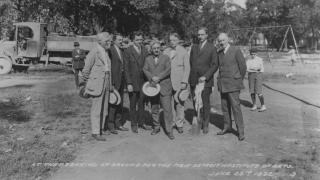
In the wake of the Virginia Tech shootings, people at a gun range near the campus recalled a young man who was also at the range, shooting targets on the ground as he walked by them.
It was odd behavior that people noticed, but no one reported it at the time. People felt it was better to mind their own business — until that man killed 32 and injured 17 at the college.
“We now know he was practicing shooting fallen bodies and training himself to make sure to get people on the ground,” UM-Dearborn Security Lieutenant Tommy Williams said at a Run, Hide, Fight training on campus earlier this week. The Run, Hide, Fight protocol was developed by the Department of Homeland Security and the UM-Dearborn Department of Public Safety has tailored it to campus.
“In the years since that tragedy, law enforcement has learned, from talking to people who had contact with mass shooters, that there are often warning signs.”
The warning signs, and what to do if you spot any, are the updated focus on the campuswide training that began this month. Faculty, students and staff are encouraged to attend. Register for upcoming dates.
Williams — who’s facilitated the active shooter response training since they began on campus in 2015 — recently shared insight into why these sessions are important and how to best protect yourself and your colleagues from mass shootings, now a frequent backdrop of American culture.
Is UM-Dearborn a safe campus?
Yes, UM-Dearborn is a very safe campus, we work hard within the department to minimize risk to the campus community. But, as a nation, we have seen over the past 20 years that these incidents can happen anywhere. As a campus, we need to be prepared so we can stay safe.
Have you seen signs that mass shootings are beginning to decline?
Unfortunately, no. When I started doing these trainings five years ago, I thought these numbers would be on the decline by now. But there were more mass shootings across the U.S. in 2019 than there were days in the year (417). It was the highest number of mass shootings on record. I believe this 20-year period in America will be thoroughly studied by sociologists and historians to determine the root cause.
What is going on?
I can’t answer that, but studies have been done to look at the motivation of the shooter by talking to the few shooters who have survived their attacks. These men and women — often don’t want to live and they want to go out in a blaze of glory. You can’t reason with someone who’s at that point. So don’t try. Instead, protect yourself by running to a place of concealment or cover if that is an option or barricade yourself in your office with the door locked and furniture in the front of the door. The police will be on the scene within 3-4 minutes.
How can we prevent these types of incidents?
It’s all about getting law enforcement involved before it gets to that point. We’ve realized that there are signs that lead up to these incidents and we want people to recognize these warning signs so they can take action by letting someone — a supervisor, professor, C.A.R.E. team member or police — know.
Warning signs include:
• Obsession with firearms
• Studying previous mass shootings
• Announcement of violent intentions
• Violent gestures like pointing gun fingers
The key to prevention is talking to that individual before an incident occurs so that we can connect them to the support services or take more serious action if needed.
If someone reports warning signs, what happens next?
You’ll get a follow-up call from an officer to find out more about what you have witnessed. The individual will then be approached and asked questions. Your name will not be given. If the person is having difficulty where support services like counseling would help, they will be guided there. If more action is required based on what we find, we will take action. But you will remain anonymous.
If someone wants more information about this, what are the next steps?
Make sure you are signed up for Emergency Alerts. Go to a Run, Hide, Fight training. Watch the new video created for campus. And if you’d like more information, email Public Safety to have an officer work with your team for suggestions on a plan of action on how to best protect your spaces.
If you do see anything suspicious, know you can call DPPS at 313-593-5333. And, if there is an imminent threat, call 911.





